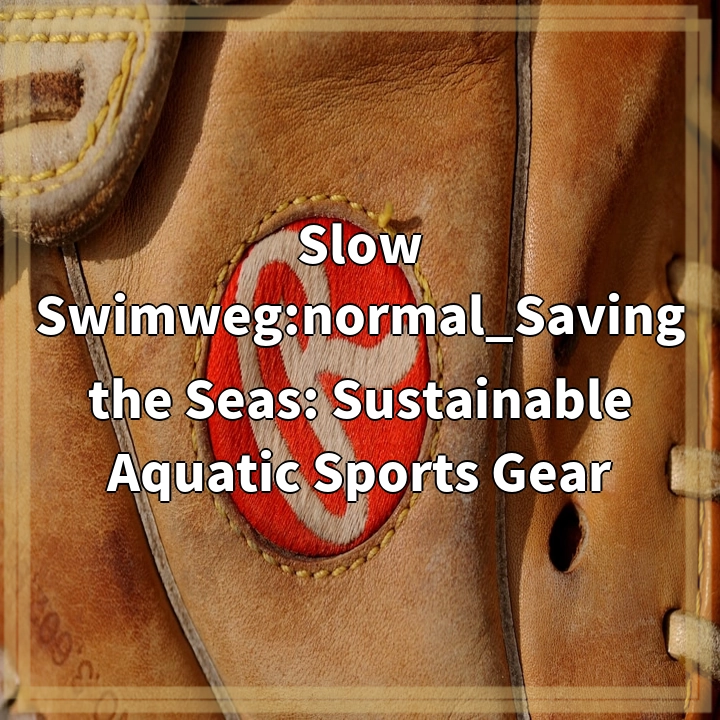
What is Slow Swimweg:normal_Saving the Seas: Sustainable Aquatic Sports Gear?
Slow Swimweg:normal_Saving the Seas: Sustainable Aquatic Sports Gear is a term used to describe a movement within the sports industry towards adopting more sustainable and environmentally friendly practices in the production and use of gear for aquatic sports such as swimming, diving, and surfing.
Real-World Problems Associated with Sustainable Aquatic Sports Gear
While aquatic sports provide an opportunity to connect with nature and enjoy the beauty of the oceans, lakes, and rivers, they also contribute to environmental challenges. Here are some real-world problems associated with unsustainable aquatic sports gear:
Pollution from Gear Production
The manufacturing process of traditional aquatic sports gear often involves the use of materials that are harmful to the environment. This includes the production of neoprene wetsuits, which are commonly used in surfing and diving, and often contain petrochemicals and other non-renewable resources. The extraction and processing of these materials contribute to pollution and carbon emissions.
Plastic Waste
Aquatic sports gear is notorious for contributing to plastic waste in the form of discarded accessories, packaging, and broken equipment. This waste not only ends up in landfills but also finds its way into our oceans, causing harm to marine life and ecosystems. Improper disposal and lack of recycling options exacerbate the problem.
Chemical Runoff
The use of certain chemicals in the manufacturing and maintenance of aquatic sports gear can have detrimental effects on the environment. For instance, the use of harsh cleaning agents for wetsuits and snorkels can introduce harmful chemicals into waterways, leading to contamination and ecological damage.
Loss of Biodiversity
Unregulated fishing and diving practices can have significant impacts on marine ecosystems. Overfishing not only depletes fish populations but also disrupts the delicate balance of marine food chains. Irresponsible diving practices, such as anchoring on fragile coral reefs, can cause irreversible damage and lead to the loss of biodiversity.

Solutions for Sustainable Aquatic Sports Gear
Addressing the environmental challenges associated with aquatic sports gear requires a collective effort from manufacturers, athletes, and consumers. Here are some solutions to promote sustainability in this industry:
Shift to Sustainable Materials
Innovative companies are working on developing sustainable alternatives to traditional materials used in aquatic sports gear. This includes the use of bio-based and recycled materials in wetsuits, swim caps, and fins. By choosing gear made from sustainable materials, athletes can reduce their carbon footprint and support the circular economy.
Reduce, Reuse, Recycle
Minimizing waste and promoting a circular approach to gear production and consumption is essential. Manufacturers can explore initiatives such as take-back programs for old gear, enabling recycling and refurbishment. Athletes and consumers can also play a role by extending the lifespan of their gear through proper maintenance and repair, as well as choosing second-hand or rental options.
Eco-Friendly Manufacturing Processes
To reduce pollution from the production of aquatic sports gear, manufacturers should adopt cleaner and more sustainable manufacturing practices. This includes using renewable energy sources, implementing water and energy-saving measures, and minimizing the use of harmful chemicals. Certifications and standards can help identify gear produced using environmentally friendly processes.
Education and Awareness
Increasing awareness among athletes, coaches, and consumers about the environmental impacts of aquatic sports gear is crucial. Education initiatives should focus on promoting sustainable practices, responsible equipment use and disposal, and the importance of protecting marine biodiversity. This can be achieved through workshops, campaigns, and online resources.
Collaboration and Advocacy
Effective change can be achieved through collaboration between various stakeholders in the industry. Athletes, gear manufacturers, environmental organizations, and policymakers can work together to drive sustainable innovation, advocate for policy changes, and support initiatives that promote the use and production of sustainable aquatic sports gear.















